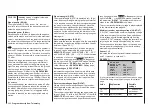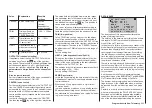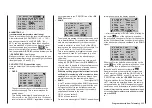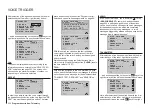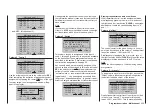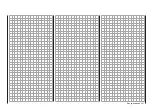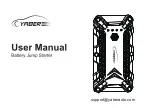
246 Program description - Telemetry
RX FAIL SAFE
INPUT CH: 01
MODE : FAI-SAFE
F.S.POS. : 1500µsec
DELAY : 0.75sec
OUTPUT CH: 04
POSITION : 1500µsec
FAIL SAFE ALL: NO
In this case, the servo connection 04 would, in turn,
react according to the fail-safe settings of CH 01.
The reaction or delay time set in the “DELAY” line, on
the other hand, always applies uniformly for all chan-
nels set to “FAI(L) SAFE”.
RX FREE MIXER
RX FREE MIXER
MASTER CH: 00
SLAVE CH : 00
S–TRAVEL–: 100
S–: 100
MIXER : 1
RX WING MIXER
TAIL TYPE: NORMAL
Value
Explanation
Possible settings
MIXER
Mixer selection
1 … 5
MASTER
CH
Signal source or
source channel
0, 1 … depending
on receiver
SLAVE CH
Target channel
0, 1 … depending
on receiver
S-TRAVEL–
Admix negative
0 … 100 %
S-
Admix positive
0 … 100 %
RX WING
MIXER
TAIL TYPE
tail type
NORMAL,
V-TAIL, ELEVON
(vertical/horizontal
mixer for delta and
flying wing)
MIXER
Up to five mixers can be programmed simultaneously.
Use “MIXER” to switch between mixers 1 … 5.
The following settings in this display always for just
the mixer selected in the “MIXER” line.
Important notice:
If you have already programmed mixer functions
in the »Wing mixer« or »Free mixer« menus, make
absolutely sure that these mixers do not overlap
with those in the menu “RX FREE MIXER”!
MASTER CH (“from”)
According to the same principles described in the
section “Free mixer” on page 204, the signal applied
at the MASTER CH (signal source or source channel)
is mixed to a variable extent to the SLAVE CH (target
channel).
Select “00” if no mixer should be set.
SLAVE CH (“to”)
The signal of the MASTER CH (source channel) is
mixed proportionally to the SLAVE CH (target chan-
nel). The mix ratio will be determined by the percen-
tages entered in the lines “TRAVEL–” and “TRA-
VEL+”.
Select “00” if no mixer should be set.
TRAVEL–/+ (proportion of the admix in %)
With the settings of these two lines the percentage
of the admix is specified in relation to the MASTER
signal separately for each direction.
RX WING MIXER TAIL TYPE (tail unit type)
The following model types are also available in the
“Tail” line of the »Model type« menu, on page 104
and should, preferentially, be preset there. In this
case, always leave the TAIL TYPE set to NORMAL.
However, if you would prefer to use the mixer inte-
grated in the receiver, you can select the already
pre-adjusted mixer functions for the corresponding
model type:
• NORMAL
This setting corresponds to the classic aircraft
type with rear tail unit and separate rudder and
elevator. No mixer function is necessary for this
model type.
• V-TAIL (V-tail unit)
With this model type the elevator and rudder con-
trol functions are connected, so that each of the
two tail unit flaps – each controlled with a separate
servo – assume both the elevator and rudder func-
tion.
The servos are normally connected to the recei ver
as follows:
OUTPUT CH 3: Left V-tail servo
OUTPUT CH 4: Right V-tail servo
If the servo’s direction of rotation is incorrect,
please observe the notices on page 73.
• ELEVON (delta/flying wing models)
The servos connect at the outputs 2 and 3 as-
sume the aileron and elevator function. The servos
are normally connected to the receiver as follows:
OUTPUT CH 2: Left horizontal/vertical
OUTPUT CH 3: Right horizontal/vertical
If the servo’s direction of rotation is incorrect,
please observe the notices on page 73.
RX CURVE (EXPO)
RX CURVE
TYPE : B
CURVE1 CH : 02
TYPE : B
CURVE2 CH : 03
TYPE : B
CURVE3 CH : 04
Value
Explanation
Possible settings
CURVE1,
2 or 3 CH
Channel
assignment of the
respective curve
setting
1 … depending on
receiver
Summary of Contents for HoTT MC-16 Series
Page 1: ...Programming Manual mc 16 mc 20 HoTT 1 en mc 16 mc 20...
Page 27: ...27 For your notes...
Page 53: ...53 For your notes...
Page 61: ...61 For your notes...
Page 65: ...65 For your notes...
Page 71: ...71 For your notes...
Page 103: ...103 For your notes...
Page 107: ...107 For your notes...
Page 111: ...111 For your notes...
Page 155: ...155 For your notes...
Page 165: ...165 For your notes...
Page 201: ...201 For your notes...
Page 229: ...229 For your notes...
Page 231: ...231 For your notes...
Page 261: ...261 For your notes...
Page 265: ...265 For your notes...
Page 301: ...301 For your notes...
Page 327: ...327 For your notes...
Page 328: ...328 For your notes...











